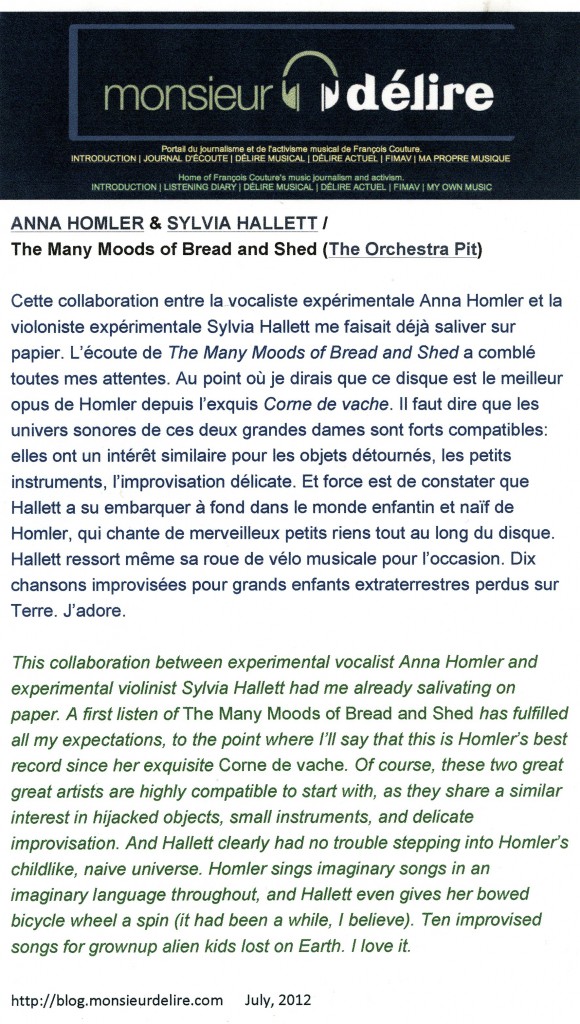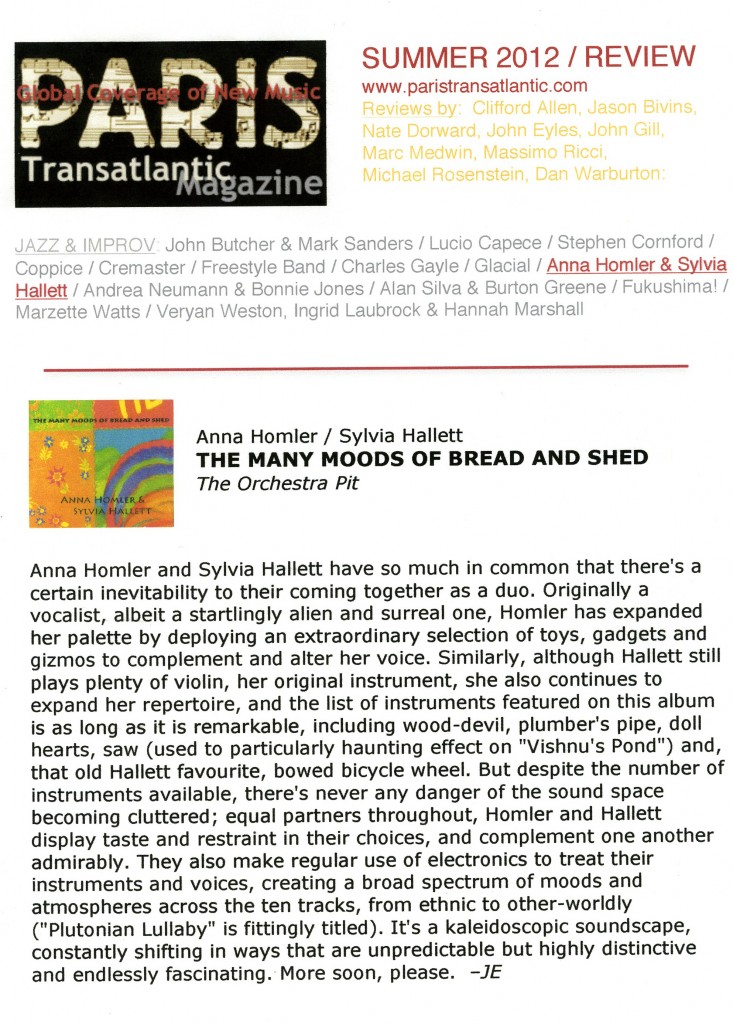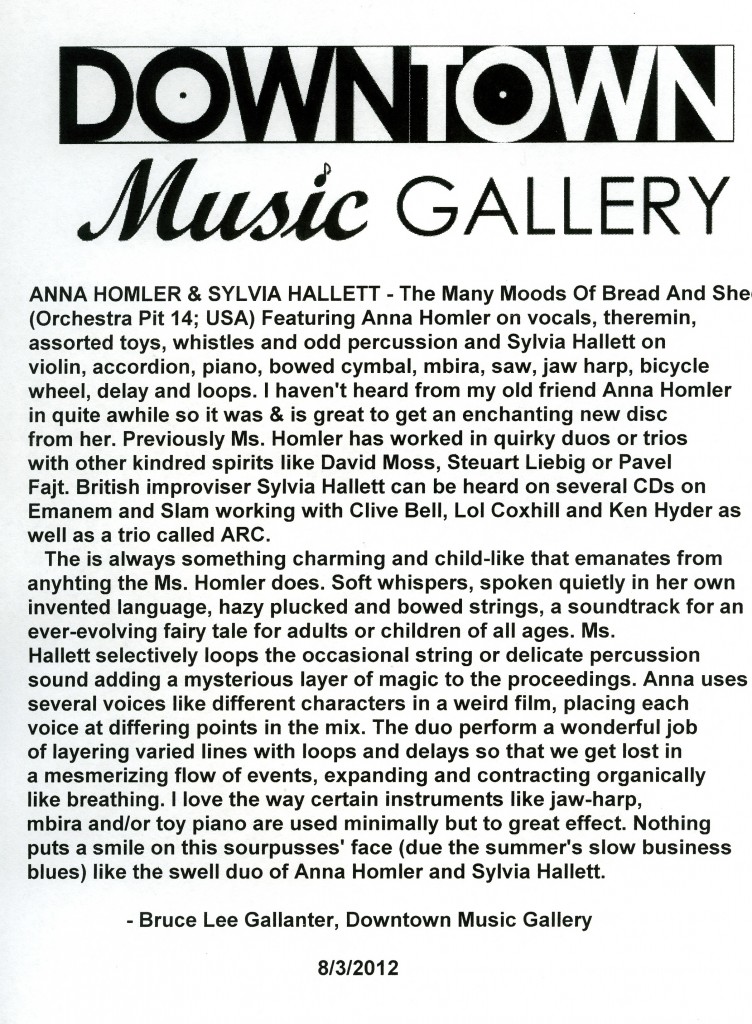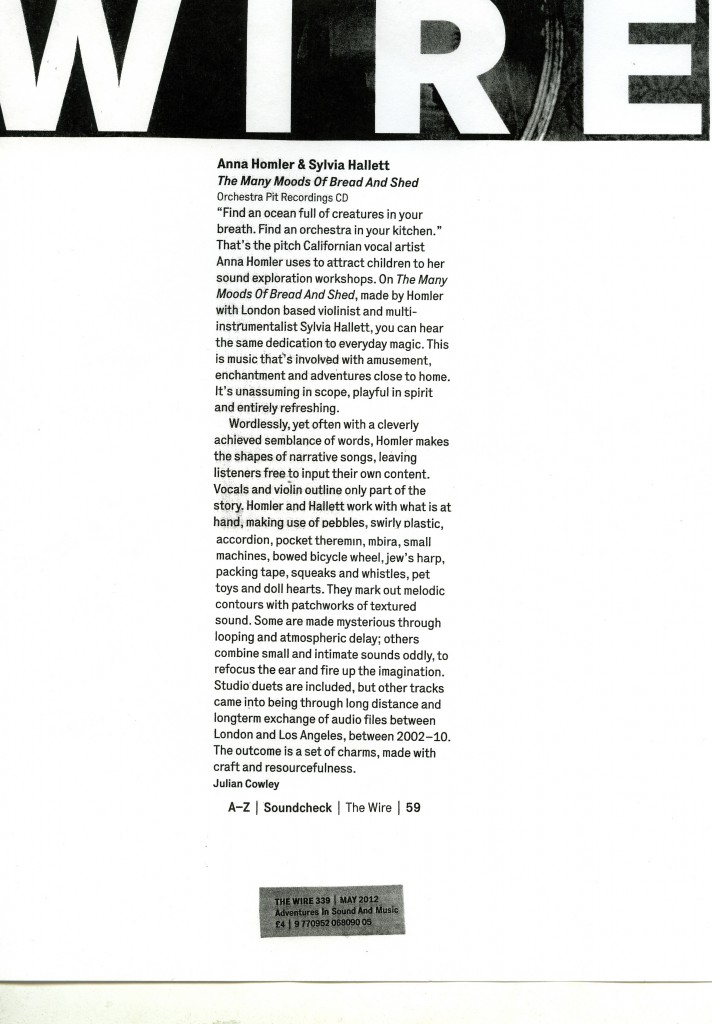Pitchfork Track Review: “Ee Chê”
 This cosmic speaking-in-tongues channeled the voice of a character called Breadwoman.
This cosmic speaking-in-tongues channeled the voice of a character called Breadwoman.
AH_Pitchfork2
Quench Review: Breadwoman
The major talking point of the Saturday schedule was that of Breadwoman, a product of cult 80s release Breadwoman & Other Tales given a physical performance by Anna Homler, Steve Moshier and the Breadwoman herself.
AH_QuenchReview: Pitchfork
In 1985, Los Angeles performance artist Anna Holmer recorded a series of shamanistic dream-songs with Southern California composer Steve Moshier, who accompanied Homler’s chants with watery synthesizers and rubbery electronic pulses.
ah_pitchforkInterview: Juno Plus – Breadwoman
Speaking in Tongues
To celebrate the arrival of her reissued album
on RVNG, Anna Homler details the three
decade-old story behind Breadwoman in this
delightful interview with Brendan Arnott.
ah_junoplus
Review: Inverted Audio
Breadwoman and Other Tales is a potent document of a time an artist could shroud themselves in mystery, creating an entire mythology, it was close to impossible for anyone outside of their immediate ‘scene’ to penetrate.
ah_invertedaudiohhv.de Album Review: BREADWOMAN & OTHER TALES
ALBUM REVIEW: RVNG INTL. COMPILES DIY MYSTICISM FROM 80S LA ON BREADWOMAN & OTHER TALES
The Attic: A Story of Bread
Test Pressing Review
Frieze Review
FACT Interview: BREADWOMAN RISES – THE MAKING OF A MODERN MYSTIC
Expose Review

In the early 80s, performance artist Anna Homler crossed paths with avant-garde composer Steve Moshier, and this collaboration was the result. Moshier took recordings of Homler’s wordless vocalizations and conceived other parts to accompany them, sometimes percussive, sometimes droning and ambient, always fitting with whatever she did. Some of the pieces, like “Ee Chê,”feature rhythmic chanting of invented syllables that sound as if they might be words in some unknown language; others, such as
the lengthy “Sirens,” consist of swoops, groans, crackles and other “non-musical” vocal noises. Moshier pairs themsympathetically, with “Ee Chê” presenting processed percussion with a relentless beat, and “Sirens” consisting of long synthesizer tones fading in and out. Each of the tracks has its own identity and sound. When it comes to abstract vocalizing (or whatever term you choose to cover Homler’s type of singing), there is a great danger of creating sounds that are very harsh and likely to repel many listeners (I’m thinking of performers like Diamanda Galás), and while Breadwoman is not for everyone, Homler never
comes off as abrasive. This music represents a middle point in performance art music – not as poppish as most of Laurie Anderson’s work (and certainly more abstract, given the lack of words), not as difficult as Galás. As such, it works admirably as its own thing, a creative vision of an alternative way of creating music outside the conventions of typical songcraft. And it’s also a rather enjoyable listen.
Sequenza 21/ Review

Breadwoman & Other Tales is a recently-released CD on the RVNG Intl label featuring the music of Anna Homler and Steve Moshier. Breadwoman is the persona adopted by vocalist Homler and the liner notes describe her as follows: “Breadwoman is a guide, a storyteller and an observer of human events. She communicates with gestures and songs in a language that is both mysterious and familiar. Breadwoman is so very old that she stands outside of time. Her territory is that of the interior, where there are no distinctions and all things are whole.”
Although the CD was released in February 2016, the music dates from the early 1980s Los Angeles new music scene. Anna Homler was deeply involved in performance art and recorded the vocalizing that ultimately became Breadwoman as she drove around town in her car. At the same time Steve Moshier was a percussionist with the Cartesian Reunion Memorial Orchestra, often performing at the same experimental dance and theater venues where Homler appeared. Their collaboration was natural, with Anna supplying her cassette recordings to Moshier, who created the electronic accompaniment. The process was iterative – the vocals evolving as each version of the electronics was realized. This was a complex and time-consuming undertaking given the technology of the time – Moshier was working with a Kurzweil K2000 synthesizer, a Prophet analog synth, a Sequential Circuits sequencer along with 2-track and 4-track tapes.
The resulting tracks on Breadwoman & Other Tales are remarkable for their convincing insight and invocation of primal music. None of the vocal lines are heard in English but are rather spoken in some unknown ancient tongue, perhaps Eastern European in origin. The melody lines are clear and precisely sung by Ms. Homler, and the strange accents and words persuasively evoke life in a small village thousands of years ago. Moshier’s electronic accompaniment is completely contemporary and, by comparison, futuristic. This makes for an engaging balance – the timeworn words and melodies offset by analog electronic tones, adding to the mysterious and mystical feel in all these pieces.
Even without comprehensible words or context, the songs are recognizable for the human emotions they express. Anna Homler studied anthropology as an undergraduate at UCLA and the daily ebb and flow of primal society fills each of these pieces. Gu She’ Na’ Di, track 3, could be a folk melody about new love – full of optimism and hope – with a clarinet line that compliments the singing perfectly. Giyah on track 4, however, is solemn and deliberate, sung mostly in the lower registers, as if some sad event in village history is being recounted. Sirens, on track 6, is full of deep electronic tones and a menacing, predatory growl that invites fear and panic – reminding us that primal existence is precarious, full of uncertainty and danger.
Oo Nu Dah, track 2, has a mysterious pulsating in the electronics with a slightly alien feel as a faint voice comes to the top of the texture, chant-like, in a prayer of supplication. The melody becomes layered – perhaps a proto-canon – and it is as if we are witness to the origins of devotional worship. Celestial Ash, the final track, takes this to the collective level in a cloud of quiet whispers as a distant electronic humming sound emerges, building in volume – as if the sun is rising on the assembled. Voices are heard in short phrases and the electronics evoke a dignified alien presence. A melodic recap of the opening is sung – the language sounds vaguely Celtic – and we could be present at the annual gathering at Stonehenge 4000 years ago.
Breadwoman & Other Tales takes us back to a time when life was highly spiritual and lived in the moment. This CD reminds us that our brains are hardwired for the primal life, and we still respond to its ancient rhythms and sensibility.
Link to Review
http://www.sequenza21.com/cdreviews/2016/04/breadwoman-and-other-tales/
Review: Exclaim
ALBUM REVIEW: ANNA HOMLER / STEVE MOSHIER – BREADWOMAN &
OTHER TALES by Will Pearson
Brooklyn label RVNG continues its program of idiosyncratic and avant-garde releases with this reissue of
Anna Homler and Steve Moshier’s 1985 foray into imagined myth, invented language and ambient
electronica. Even by RVNG’s standards, Breadwoman and Other Tales is weird. This music sounds not just
like it’s been unearthed from another time, but from outside of time altogether.
Homler (a performance artist) met Moshier (an avant-garde musician) in L.A.’s underground gallery culture in the early ’80s. She had already developed the character of Breadwoman, “a woman so old she’s turned to bread,” and a form of extra-linguistic incantation and chant that she’d been recording onto cassette. She gave the cassettes to Moshier, who composed ambient soundscapes to accompany them using 2-track and 4-track tape recorders, synths, effects and a sequencer.
The result is a record that feels meaningful despite its nonsensical language, which doesn’t sound dated in the least, neither sonically nor stylistically. “Oo Nu Dah” is an early highlight, and finds Moshier looping and multi-tracking Homler’s voice into Reich-like echoes that produce unnerving harmonies. “Sirens” is a terrifying excursion into the primordial, with Homler delivering inhuman squeaks, squeals and groans that evoke both birth and death.
If you’re looking for a record to give your bohemian wine tasting an air of inscrutable sophistication, this record will do the trick, but it’s better than that; it demands and deserves a quiet concentration in order for its transcendental ambitions to flourish. (RVNG Intl.)
Rating: 8/10
Review: Boomkat
ALBUM REVIEW: ANNA HOMLER / STEVE MOSHIER –
BREADWOMAN & OTHER TALES
Spellbinding transmission from the esoteric melting pot of early ’80s L.A.; an expanded reissue of the eponymous debut release by Anna Homler & Steve Moshier’s sound art duo, Breadwoman, including two
bonus, previously unreleased pieces.
First kneaded in 1982 by performance artist Anna Homler, Breadwoman arose as a “being who exists outside of time”, intersecting various strands of L.A.’s art scene – gallery culture, DIY avant-garde, meaning-making mysticism – with a combination of gauzy electronics, glossolalic vocalese, and a costume made out of bread.
You can certainly colour us beguiled at Breadwoman & Other Tales, presenting the original tape’s alien song cycle – from the primordial shuffle and curiously Japanese-sounding vocalese of Ee Chê, thru the floating prisms of Oo Nu Dah, to the Rashad Becker-esque electronics of Giyah and kosmiche crème of Yesh’ Te – whilst the two bonus tracks angle far, far-out into stunning cinematic abstraction sounding like Helge Sten scoring a Lynch flick with the 12 minute Sirens, whereas Celestial Ash scries a precedent to everything from Enya and Julia Holter to Anna Caragnano & Donato Dozzy’s Sintetizzatrice.
Can easily predict this becoming an end-of-year favourite. Recommended!
Review: Avoiding Silence

ALBUM REVIEW: ANNA HOMLER / STEVE MOSHIER –
BREADWOMAN & OTHER TALES
In the early 80s, performance artist Anna Homler crossed paths with avant-garde composer Steve Moshier,
and this collaboration was the result.
Moshier took recordings of Homler’s wordless vocalizations and conceived other parts to accompany them, sometimes percussive, sometimes droning and ambient, always fitting with whatever she did. Some of the pieces, like “Ee Chê,” feature rhythmic chanting of invented syllables that sound as if they might be words in some unknown language; others, such as the lengthy “Sirens,” consist of swoops, groans, crackles and other “non-musical” vocal noises. Moshier pairs them sympathetically, with “Ee Chê” presenting processed percussion with a relentless beat, and “Sirens” consisting of long synthesizer tones fading in and out.
Each of the tracks has its own identity and sound. When it comes to abstract vocalizing (or whatever term you choose to cover Homler’s type of singing), there is a great danger of creating sounds that are very harsh and likely to repel many listeners, and while Breadwoman is not for everyone, Homler never comes off as abrasive.
This music represents a middle point in performance art music – not as poppish as most of Laurie Anderson’s work (and certainly more abstract, given the lack of words), not as difficult as Galás. As such, it works admirably as its own thing, a creative vision of an alternative way of creating music outside the conventions of typical songcraft. And it’s also a rather enjoyable listen.
Review: Aquarium Drunkard — Breadwoman
March 15, 2016
The genesis of Breadwoman stretches back to the early ’80s, when performance artist Anna Homler found herself singing while driving through Topanga Canyon, chanting out in a strange, rhythmic cadence.
Homler’s melodies weren’t from any language she recognized, but felt like more than just absentminded moans or nonsensical babbles to her. “I still remember the moment,” Homler says via the telephone. “It was a
language I didn’t know but it was musical and melodic.”
Link to Aquarium Drunkard Article online
AH_AquariumDrunkardEl Chamberlin Review and Interview
Revealing The Hidden Nature of Everyday Things.
ElChamberlin_Feb2016_AnnaHomler-1
*Scroll over bottom part to access all 6 pages.
Review: The Attic — Breadwoman & Other Tales

Breadwoman & Other Tales has the feel of freshly resurfaced collected recordings from a forgotten tribe. It is in fact the organic collaboration between Anna Homler and Steve Moshier.
In her artistic practice, Anna Homler approaches visual arts, performance and sound art. In 1982, she assumes the role of Breadwoman and documents her magical speech in the form of rhythmic, melodic sound. The Breadwoman character is outlined as being so old she turned into bread. By positioning herself outside the space or time linearity, it is almost impossible to contextualize her. The project was subjected to a musical dimension when Steve Moshier joined in, complementing the recordings by composing, mixing and engineering the music.
Breadwoman & Other Tales is, dare I say, so much more than a musical project. How can such a fundamental need – that of singing or producing sounds – have such a modern approach to it? I think the answer here is its forward-thinking interdisciplinarity. The LP inhabits the skin of an intricate art project that enmeshes artistic mediums such as performance, photography and music, while investigating language and its systems.
Anna Homler tackles language by inventing a new one, completely displacing its conventional structuralism and meaning. Just by the simple act of opening her mouth and modulating the flow of air being expelled from her lungs, she delivers a plethora of haunting sounds, seemingly impossible to discern, far from any language known to us.
The sounds she produces indeed suggest a vocal construct akin to the wisdom of an old woman and the naïveté of a little girl at the same time. If you really feel the need to pinpoint it, it could resemble shamanic rituals, with their inherent primal and earthy qualities. This invented language reaches such a level of musicality that it is easy to blur the fringe of contact between music and language. Roland Barthes underlined this idea in his series of interviews called The Grain of Voice. He argued that this very precise space, the encounter between a language and a voice, which he calls “the grain of the voice”, occurs when the latter is in a dual posture, a dual production – of language and of music.
Steve Moshier manages to give birth to some sort of ritualistic mythical electronica, powerful yet subtle, so as to not drown Breadwoman’s enthralling melodies. He uses her voice as a sonic element, interweaving its meshes with the warmth of analog sounds.
The sixth piece, Sirens, stood out to me the most. It is engulfed in a reverberating primordial screech, reminiscing of the eerie sounds the sirens use to lure sailors into certain death. The effect of this one is disarming. I will let you discover by yourself the rest of the pieces. This is a unique musical journey into thought, to be carefully listened in its entirety.
Here & Here & Here Review in Jazzword
The CD presents five gifted improvisers expressing a myriad of emotions thoughtfully developed and masterfully executed.
 Ken Waxman on Here & Here & Here
Ken Waxman on Here & Here & Here
Jazzword, December 16 , 2014
http://www.jazzword.com/one-review/?id=128640
“A spatial rather than a geographical description, the 15 tracks on this CD add up to an object lesson in how to integrate an improvising vocalist`s skills with a prime Free Music ensemble. At the same time the well-balanced and inventive program confirms that not all of California’s experimental improvisers are clustered in the Bay area.
Los Angles trumpeter Jeff Kaiser and San Diego trombonist Michael Vlatkovich have for many years waved the Free Jazz banner all over the golden state. Meanwhile LA vocalist Anna Homler has been forced to take her talents overseas to concertize with Brits like pianist Steve Beresford and violinist Sylvia Hallett. No variation of those chordal instruments is on hand here. Basically Here & Here & Here relies on the inventive pumping of bassist Scott Walton and the concentrated beats of percussionist Rich West to keep the bottom balanced as the front line works through novel sound strategies.
Committed to vocal expression that takes from vocalese, nonsense syllables, shamanistic ritual and double talk, Homler’s contributions often could be imagined as coming from a non- English-speaking-vocalist unexpectedly paired with a hip Jazz combo. At the same time though, her vocal shading, reminiscent to that of Lauren Newton and other Free Music songsters, take the place of a horn in arrangements for some tracks. With brass fully accounted for, think of Homer as a saxophonist doubling soprano and alto.
If the CD does have a drawback though, it’s the extreme brevity of some of the selections. Two minutes may be long enough for a Pop single, but with improvised music that time-span merely gives players space to suggest a concept; organic sounds like organic food take longer to nurture. Other selections which initially could develop more forcefully end up being scene-setting rather than completed creations. Popping ‘bone tones, triplet brass interludes and percussion nerve beats stand out on their own, but adds up only to a fanfare, a liquid interlude or a tone demonstration rather than a complete statement.
Much more substantial are those pieces which integrate unexpected asides within the tunes’ chromatic concepts. Textures that could arise from a kazoo, a marimba, a steel drum or a bird- caller – replicated or real – are used as color. Possessed of a Maggie Nichols-like ability to articulate nonsense syllables as if she’s singing in a legit language, on the title track Homler sweetly spins out her lines while matched by plunger trombone and guttural Jew’s harp twangs. On the other hand, as a percussion interlude clangs savagely on “Red Coda” she puts aside her reed-replication that chases timbres along with the horns for squeezed bel canto expression.
Sweetness or strength from Homler’s vocal chords and embouchure are the key variables on many of the other tunes. Growling made-up language serves its purpose when matched with trombone plunger retches or vibrated trumpet chirps, just as a lyric soprano expositions can cut through dense brass slurs to add delicacy to improvisations that could turn self-indulgent.
Overall the five players distinguish themselves as sound experimenters – and original ones at that. But next time H&H&H records, giving themselves expanded space in develop their unique expression would be beneficial for both the band and listeners.”—Ken Waxman
Find out more: http://www.pfmentum.com/PFMCD084.html
Review: Rockerilla
Imaginative, colorful as its cover, this collaboration between two musicians, Sylvia Hallett, a name well known in the British underground spontaneous music and Anna Homler, American, also known in the underground scene of Los Angeles.
This album sees the light after a long gestation since 2002, the year of the first collaboration / improvisation duo, arrives today. Elements sweet, from lunar memories are reflected in environmental drones and voices. Minimalist noise elements, muted sounds of marimba and noises, as in the great Vishnu’s Pond, to give carnal substance archaic divinity. Elements of the work of Philip Glass and Meredith Monk (Sea Of Vapours, which opens the album makes devout homage with sinuous twists of whispering voices and violins), but also by Pascal Comelade (the accordion irresistible in Jolly Chondra) and some Nordic folk converge with extraordinary formal unity despite the linguistic diversity in an album smells of genius where elements of folk, electronic (the final song, Les Perdues, symphonic poem for analog synthesizers, is a tribute to the first, vast Tangerine Dream), contemporary classical, noise are syncretic life in a universe full of emotional depth, humor and rare musical intelligence. from Not to be missed.
–
Un album a dir poco fantasioso, multicolore come la sua copertina, questa collaborazione tra due musiciste, l’inglese Sylvia Hallett, nome assai noto nell’ambiente della musica spontanea underground britannica e Anna Homler, americana, anche lei nota nella scena underground di Los Angeles. Questo album vede la luce dopo una lunga gestazione che dal 2002, anno della prima collaborazione/improvvisazione del duo, arriva a oggi. Elementi dolcissimi, provenienti da memorie lunari trovano riscontro in droni ambientali e ninannanne vocali. Noise, elementi minimalisti, tenui suoni di marimba e rumore, come nella notevole Vishnu’s Pond ,a dare carnale sostanza all’arcaica divinità. Elementi del lavoro di Philip Glass e di Meredith Monk (Sea Of Vapours, che apre l’album ne rende devoto omaggio con sinuosi intrecci di voci sussurrate e violini), ma anche di Pascal Comelade (la fisarmonica irresistibile in Jolly Chondra) e di certo folk nordico confluiscono con straordinaria unità formale pur nella diversità linguistica in un album che profuma di genio dove elementi folk, elettronica (il brano finale, Les Perdues, poema sinfonico per sintetizzatori analogici, è un omaggio ai primi, immensi Tangerine Dream), classica contemporanea, noise trovano sincretica vita in un universo ricco di profondità emotiva, humour e rara intelligenza musicale. Da non perdere.







